Key takeaways:
- Phishing attacks exploit emotions like fear and urgency, making victims prone to responding without caution.
- Recognizing phishing signs such as suspicious URLs, poor grammar, and urgent requests is crucial for protecting personal information.
- Privacy advocacy is essential for empowering individuals with knowledge about their rights and influencing data protection legislation.
- Implementing strategies like strong passwords, two-factor authentication, and regular reviews of privacy settings can significantly enhance online security.
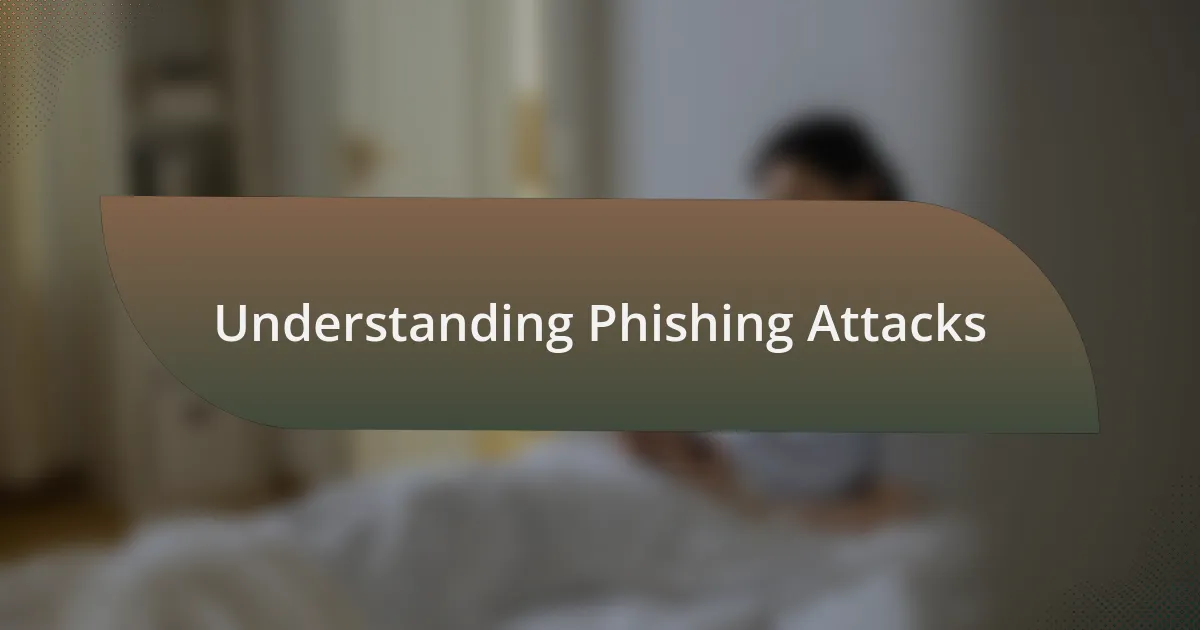
Understanding Phishing Attacks
Phishing attacks can be deceptively simple yet incredibly effective. I remember receiving an email that looked convincingly like it was from my bank, urging me to verify my account details. The initial rush of urgency it created in me was shocking; I almost acted on it before I paused to think. How easily could I have fallen for that?
What stands out to me is the emotional manipulation behind these scams. Phishing emails often exploit fear or curiosity, making the victim feel they must respond immediately. When I see genuine friends fall victim to such attacks, it raises a question: why are we so prone to these tactics? The sense of urgency they create can cloud our judgment, and I’ve had to remind myself that a moment of hesitation might just save me from a serious security breach.
Additionally, phishing isn’t just about emails; it can occur through social media, texts, or even phone calls! One time, I received a message on an app claiming to be from a tech support team, insisting that my device was compromised. It made me wonder how many people might not recognize the signs as I did. The emotional strain of trusting the wrong source is real, and understanding the various forms of phishing is vital for staying vigilant.

Importance of Privacy Advocacy
The importance of privacy advocacy cannot be overstated in today’s digital age. I recall a time when a friend was a victim of a data breach, leading to significant financial losses. It made me realize how easily personal information can slip through the cracks and the vital role that privacy advocates play in protecting individuals from such violations.
Privacy advocacy is essential because it empowers individuals with knowledge about their rights. I remember attending a workshop where experts explained how to safeguard personal data online. That experience was enlightening; it made me question how much control I truly had over my information. Have you ever taken a moment to consider how often your data is shared without your consent?
Moreover, privacy advocates work tirelessly to influence legislation and promote policies that protect our data. When I learned about new regulations designed to enhance data privacy, I felt a mix of hope and responsibility. It’s a reminder that our voices matter in shaping a future where privacy is respected and protected. How can we not support the efforts of those who fight for our right to privacy?
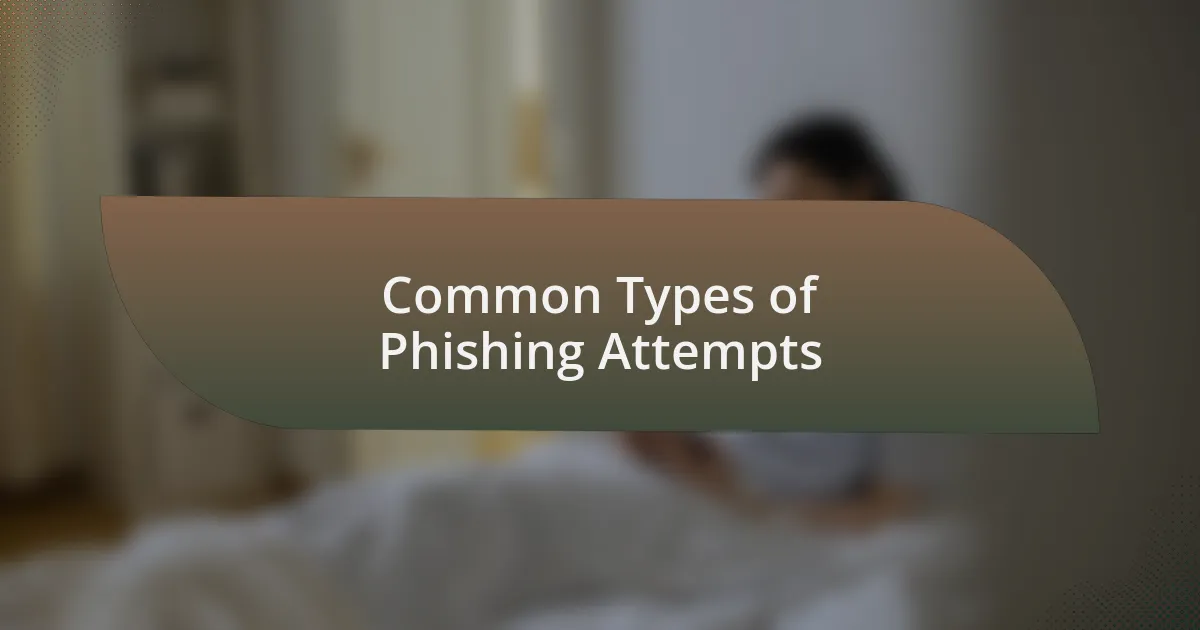
Common Types of Phishing Attempts
Phishing attempts come in various forms, each designed to exploit our trust and urgency. One type that I’ve encountered often is email phishing, where attackers pose as reputable organizations to trick individuals into divulging sensitive information. I remember receiving an email that claimed to be from my bank, urging me to verify my account details urgently. The sense of panic it instilled made me more cautious about the information I share online.
Another common type involves spear phishing, which targets a specific individual or organization. I was once in a meeting where a colleague received a message that appeared to come from our boss, requesting a sensitive document. Thankfully, we recognized the email sender’s address was slightly off. Have you ever stopped to check the sender’s information carefully? It’s these small details that can save us from significant breaches.
Lastly, there’s vishing, or voice phishing, where attackers use phone calls to trick individuals into providing personal information. A friend of mine shared a harrowing story about receiving a call from someone pretending to be from technical support. They used scare tactics to convince her that her computer was at risk. It made me realize how important it is to be skeptical, even in voice conversations. How often do we let our guard down when someone sounds convincing over the phone?
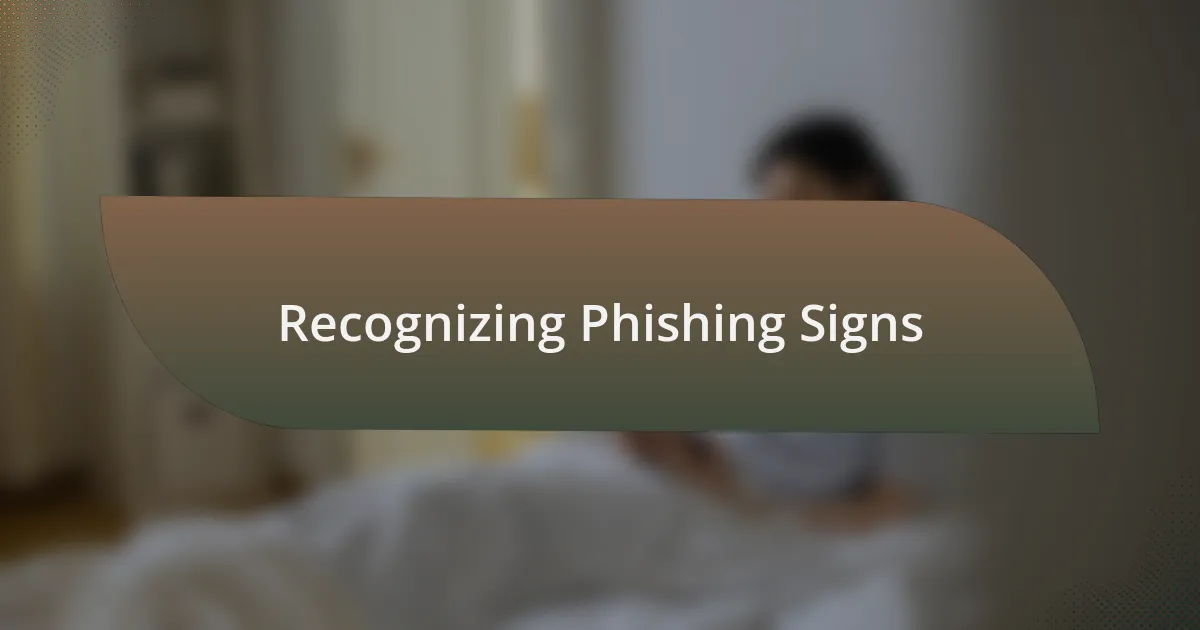
Recognizing Phishing Signs
Recognizing phishing signs is crucial for protecting our personal information. One telltale sign I’ve learned to watch for is suspicious URLs. I once clicked on a link in an email that seemed harmless, only to notice at the last second that the domain was slightly altered, replacing a “.com” with “.net.” It’s a small change, but it can lead to big trouble. Have you ever had that gut feeling when a link just didn’t feel right?
Another red flag often is poorly written content. I vividly remember getting an email riddled with typos and awkward phrases, clearly sent by someone who wasn’t a native English speaker. It made me question the legitimacy of the message instantly. When did you last pause to scrutinize the language used in such messages? Those moments of doubt can often protect us from falling into a trap.
Urgency is another common tactic in phishing attempts. I had an experience where an email claimed my account would be locked unless I acted immediately. The pressure was intense! It made me realize how attackers play on our emotions, pushing us to act without thinking. What about you? Have you ever felt rushed to respond to something that, in hindsight, seemed suspicious? It’s a reminder to take a step back and evaluate before clicking or providing any information.
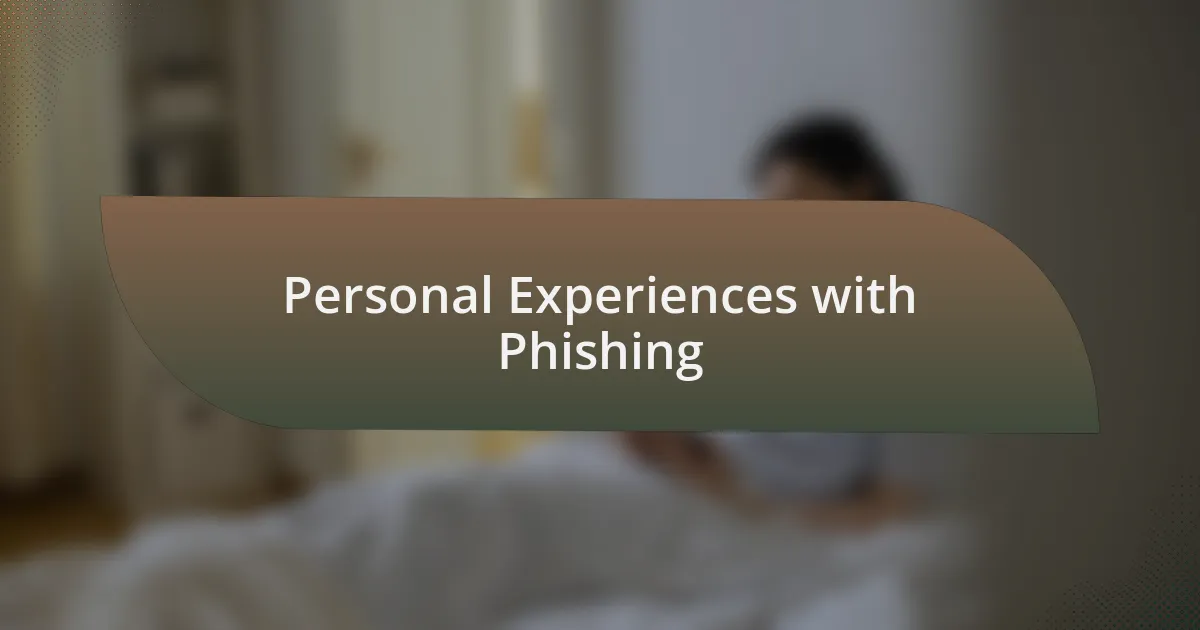
Personal Experiences with Phishing
It’s interesting how easily we can overlook the obvious when we’re caught off guard. Last year, I received a text message that appeared to be from my bank, asking me to verify a transaction. I felt that pit in my stomach, an instinctual worry that something wasn’t quite right. After some digging, I realized the number wasn’t even close to my bank’s official contact. Have you ever fallen for a message that felt just too urgent to ignore?
Then there was the time I encountered a phishing email that looked remarkably legitimate. The logo was crisp, the layout was professional, and it was addressed personally to me. What struck me was the uneasy feeling I had—it was too good to be true. Trusting that instinct ultimately saved me from sharing my details. How often do we let appearances cloud our judgment, only to feel regret later?
In another instance, I found myself almost clicking on a link that promised an amazing deal on a tech gadget. My excitement nearly led me to a trap. The moment I paused and asked myself why this deal was so enticing, I realized it was likely bait. It brings to mind an essential question: how often do we stop and evaluate the allure of a too-good-to-be-true offer? Those reflections steer us toward safer online practices.
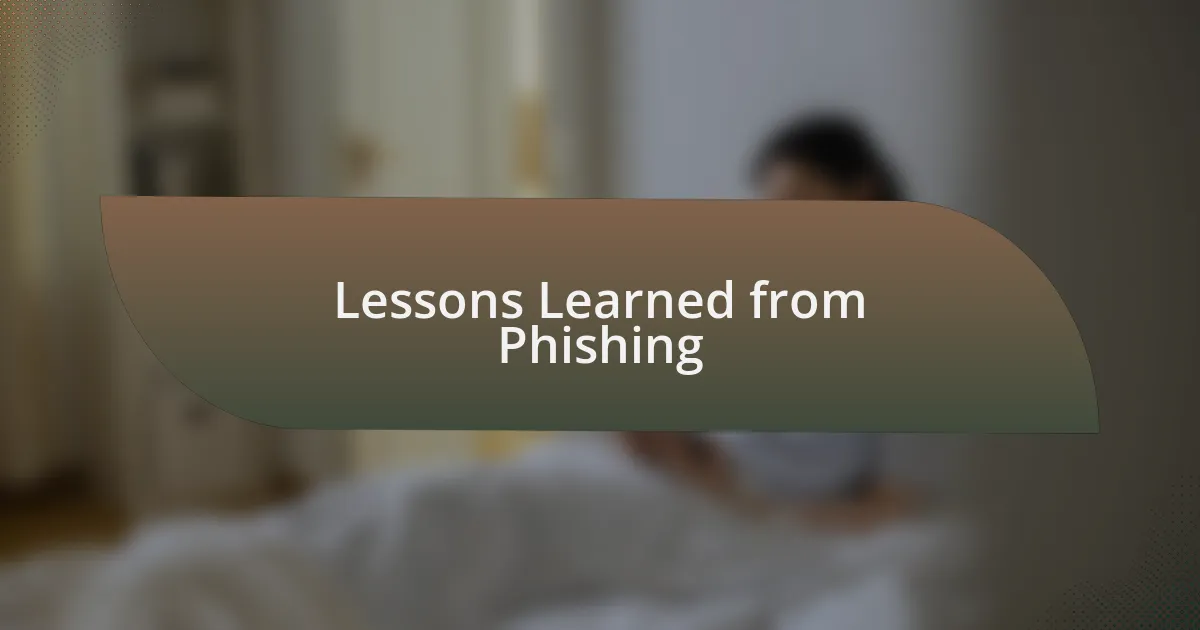
Lessons Learned from Phishing
Phishing attacks have taught me the importance of verifying communication channels. I once received an urgent email from what looked like a service I frequently used, claiming my account needed immediate attention. Instead of panicking, I chose to log in through the official website rather than clicking the link. That moment of caution not only protected my account but reinforced a key lesson: always verify before you trust.
Another lesson that stood out was the value of skepticism. I received a message offering free premium access to an online course that piqued my interest. It seemed tailored just for me, but something instinctual held me back. After a bit of research, I discovered it was a phishing attempt masquerading as a generous offer. Have you ever been tempted by something that seemed too ideal? Learning to cultivate a critical mindset has become essential for navigating online spaces safely.
Finally, I realized that education is my best defense. I’ve attended numerous webinars and read articles on cybersecurity, which have helped me identify phishing attempts more effectively. Each session enhanced my awareness, empowering me to spot red flags, like poor grammar or unexpected sender addresses. This self-education fosters a sense of confidence—how many of us rely on our instincts without arming ourselves with knowledge first? Recognizing threats is an ongoing journey that requires some investment in ourselves.
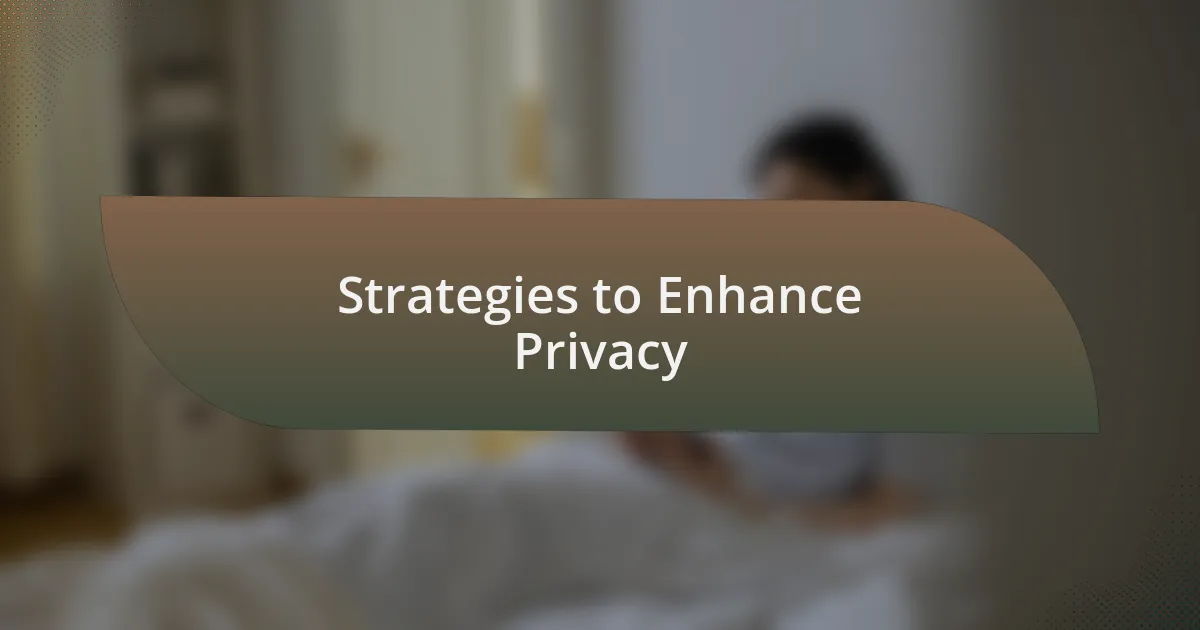
Strategies to Enhance Privacy
Enhancing privacy begins with strengthening your passwords. I’ve switched to using password managers that generate complex passwords for every account, sparing me the headache of remembering them all. Have you ever thought about the vulnerabilities of using the same password across multiple platforms? This simple change has significantly bolstered my defenses and makes it a lot harder for potential attackers to gain access.
Another effective strategy is enabling two-factor authentication (2FA). I remember the first time I set it up; it felt like adding an extra lock to my front door. The peace of mind it brought was immediate. Knowing that even if my password is compromised, a thief would still need my phone to access my accounts has been a game-changer for me. Have you considered the added layer of security 2FA could provide you?
Regularly reviewing privacy settings on social media platforms is equally crucial. I set aside time every few months to audit what I share and adjust my visibility. It surprises me how many data-sharing settings are defaulted to public. This proactive approach ensures I maintain control over my personal information, and it’s a habit I encourage everyone to adopt—do you know what your own settings reveal about you?